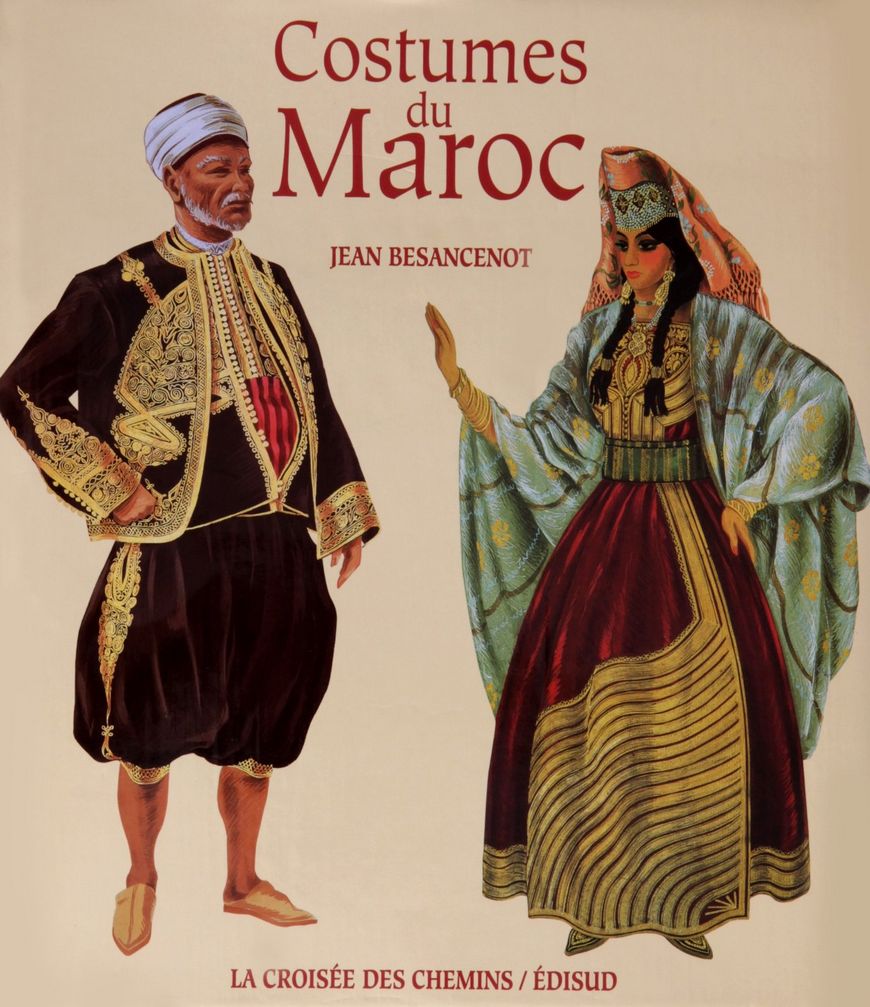In this article a short presentation of the book Costumes du Maroc by Jean Besancenot Al Kalam Editions-Diffusion.
In a vast geographical area ranging from the Middle Atlas to the heart of the Sahara, women's costumes whose origin dates back to Roman times still exist today.
Seeing the great variety of these costumes, it is hard to believe that they are practically all variations of the same very simple clothing technique, which is both Greek chiton and Roman peplum: that of the drapery.
It is a long cloth - about 4,50cm x 1,40m -, "izar" rolled up and then maintained at the waist by a belt and then brought back on the shoulders to be fixed there by fibulas.
The Moroccan Jabador is presented under variable aspects according to the regions and in spite of some common points, the city clothing differs from that of the countryside.
Over the past few years, clothing has undergone an evolution that is sometimes barely perceptible in the countryside, but striking in the cities.
Sobriety and wealth
The traditional Moroccan costume for men is characterized by the sobriety of the outer garment (jabador and djellaba) and by the great richness of the interior clothing (caftan and gandoura).
Influence
For a long time, the costume of city women has remained unchanged, but since the intensification of trade with foreign countries in the 19th century, it has been subject to the phenomenon of fashion.
This is the case of the "qaftane".
The "qaftane" has remained, until today, the basic interior clothing of the Moroccan woman.
Cut from velvet, silk or brocade, it is often richly embroidered with gold, silver or silk thread.
From haik to djellaba
Unlike the rural woman, especially the Berber woman of the High and Middle Atlas and the Saharan woman, who does not veil her face, the Moroccan city woman could not go out in the street, at least at the beginning of the 50s, without being draped with the "haik", a large piece of wool or cotton of about five meters by one meter sixty, which conceals the shapes of the body and veils the facial features.
On variation
Just like the other components of the costume of the city woman, the "djellaba" has undergone during the last four decades important variations.
While it retains the same overall structure, it has lost, except among conservative or older women, the rigour of cut and the sobriety of colour of its early days.
Fashion, yes... tradition too.
Despite all the variations it can undergo under the influence of modern life, the traditional dress constitutes the basic wardrobe of Moroccan women, all classes combined.
One only has to attend a fringe event, or any religious or other festivity, to realize how faithful Moroccan men and women remain to their finest traditions.
Moroccan clothing varies from region to region, depending on local traditions rather than a way of life; it is not dependent on any fashion.
In modern cities, European-style clothing is gaining ground, but traditional clothing is still widely worn.
The most common is the djellaba, adopted by women as well as men, it is a long garment, with sleeves, loose but straight, a "cover-all", the men put it on a wool shirt or on their suit and often fold down the hood on the tarbouche.
The gandoura is a kind of sleeveless tunic, usually white....
The caftan, that a fashion imported in Europe, is the toilet of the city girls, buttoned in front of, all the length, by small tight balls, split on the sides, it can be made for the big occasions in a rich fabric (velvet, silk, brocade), and girdled of gold or silver.
Moroccan women wear it with an embroidered belt.

